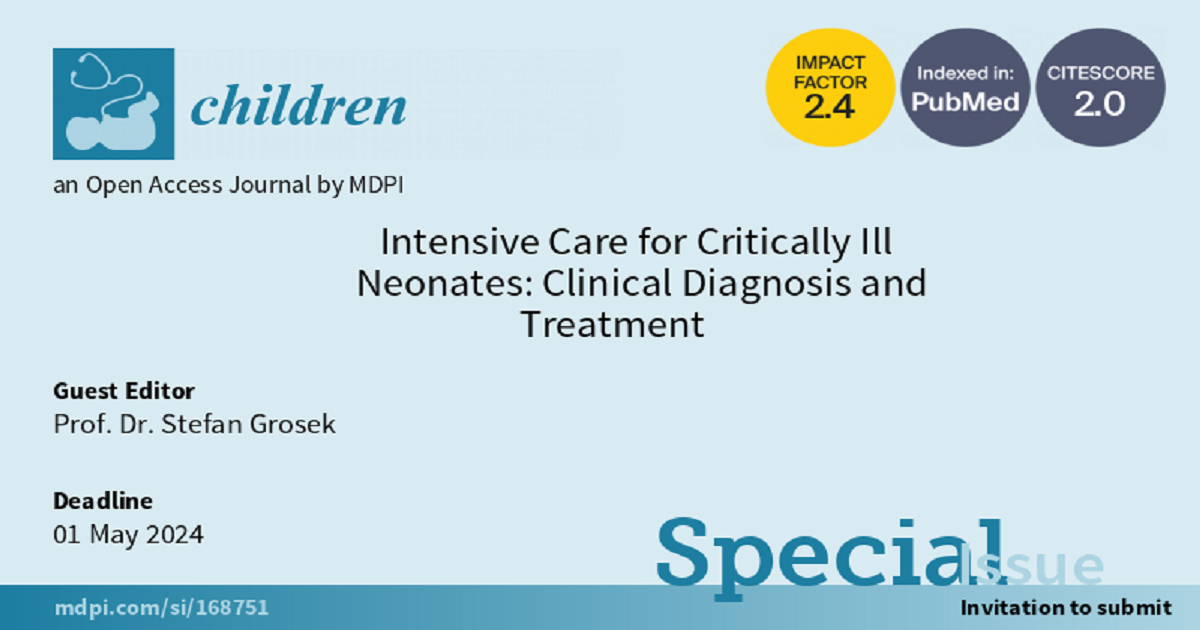Intensive Care for Critically Ill Neonates: Clinical Diagnosis and Treatment
A special issue of Children (ISSN 2227-9067). This special issue belongs to the section "Pediatric Neonatology".
Deadline for manuscript submissions: 1 May 2024 | Viewed by 9051

Special Issue Editor
2. Department of Paediatrics, Faculty of Medicine, University of Ljubljana, Bohoričeva 20, 1000 Ljubljana, Slovenia
Interests: critically ill newborn infants and children; transportation medicine; medical and research ethics; adult, pediatric and neonatal intensive care medicine; palliative care medicine; philosophy; medical ethics
Special Issue Information
Dear Colleagues,
Critically ill neonates born prematurely and at term represent a major challenge for healthcare professionals. Critically ill neonates are infants with a broad spectrum of diseases and disorders that emerge pre-, peri- or postnatally, and who need life support treatment in the neonatal intensive care unit (NICU). The NICU is a place where initial and final diagnosis, many times with the involvement of an interdisciplinary team, is confirmed, and treatment is ongoing. Great advances and improvements in diagnostics and treatment with modern technical devices have allowed us to support and rescue many infants with neonatal disorders which would have not been imaginable years ago. Treatment options involving modern life support systems (mechanical ventilation, extracorporeal membrane oxygenation, blood purification techniques, and others), surgeries and the most advanced medicines are also available in the NICU. The treatment and prevention of pain, nosocomial infections and total parenteral nutrition is of great importance, too. Healthcare professional’s support of the families of the critically ill neonates is a prerequisite for the completeness of the care of critically ill neonates. Additionally, different ethical issues may arise during intensive treatment in the NICU.
Therefore, the aim of this Special Issue is to accept for publication your interesting research which may cover any aspects of the diagnostics and treatment options, as well as the outcomes and follow-up, of the critically ill neonates in the NICU.
Prof. Dr. Stefan Grosek
Guest Editor
Manuscript Submission Information
Manuscripts should be submitted online at www.mdpi.com by registering and logging in to this website. Once you are registered, click here to go to the submission form. Manuscripts can be submitted until the deadline. All submissions that pass pre-check are peer-reviewed. Accepted papers will be published continuously in the journal (as soon as accepted) and will be listed together on the special issue website. Research articles, review articles as well as short communications are invited. For planned papers, a title and short abstract (about 100 words) can be sent to the Editorial Office for announcement on this website.
Submitted manuscripts should not have been published previously, nor be under consideration for publication elsewhere (except conference proceedings papers). All manuscripts are thoroughly refereed through a single-blind peer-review process. A guide for authors and other relevant information for submission of manuscripts is available on the Instructions for Authors page. Children is an international peer-reviewed open access monthly journal published by MDPI.
Please visit the Instructions for Authors page before submitting a manuscript. The Article Processing Charge (APC) for publication in this open access journal is 2400 CHF (Swiss Francs). Submitted papers should be well formatted and use good English. Authors may use MDPI's English editing service prior to publication or during author revisions.
Keywords
- neonatal transport
- SIRS
- induced therapeutic hypothermia
- ECMO
- surfactant
- congenital defects
- total parenteral nutrition
- inhaled nitric oxide
- outcome
- sedation and analgesia
- ethics in NICU






